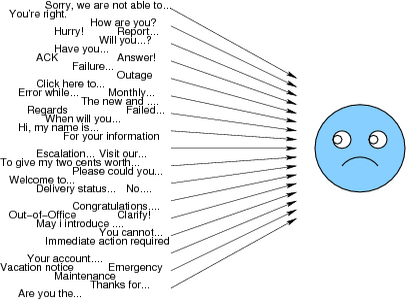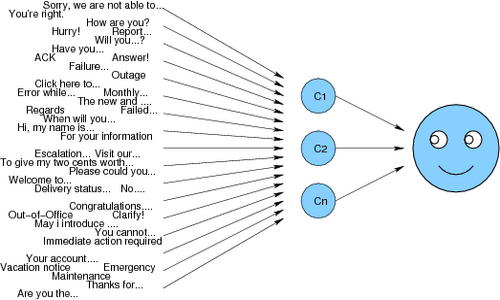Organizing email is indispensable in our days. The main task is to optimize the access to focused information. The one-shot approach would be to find categories, grouping the kind of content following several criteria.

Figure: Information Overload Without Organizing
From Overload to Manageability
Information Overload in the topic email is caused by a (too) high amount of email sent to an individual. As discussed before organizing is a good way to focus, correlate and prioritize information, separate the relevant from the irrelevant information.

Figure: Information Management With Organizing
Finding categories to presort email greatly helps managing the desired information. The possibility of a quick overview is greatly appreciated and the subjective impression accrues that the information is more manageable (see figure [woOrganizing] versus [wOrganizing]).
Information Semantics
Looking at the inbox of an average user it is obvious to distinguish different kinds of information. Every kind of email can be allocated to a special thread. Similar threads can be grouped together to special topics. The latter can be attached to a unique category (kind) of information. The term category in this case is not the appraisal of e.g. interesting and not interesting, even more it is the objective view on the semantic type of information. The kinds of email this thesis focuses on are prevalent types of average email users.
Private
Private kind of email is information sent by (and to) friends and non-business parties. Running the gamut from simple emotions (How are you?) over invitations (Will you join us on Sunday? ) and subjective discussion of every kind of topic ( How was the movie? ) indications of Private email are:
- Private Emotions
- Personal Interests
- Subjectiveness
- Social Intention
Business
Business email is all kind of information regarding business topics. Business announcements, customer correspondence, and meeting invitations are kind of business, same as daily business information, team sharing, reports, and even social mailings within the team. Indications of Business email are:
- Business Organization
- Customer Care
- Daily Business
- Instruction Issues
- Team Intention
Project
Project kind email may be a subset of project related, non daily business email, but is not subject to. Private projects can be related to this kind of information, too. Unique examples for this are software, customer, university, and any kind of private projects. Indications of Project email are:
- Project Management
- Project Participation
- Auditing and Meeting
Notification
Emails relating news, progress and status information are considered as notification email. Accurate examples are password expiry emails, account details, a won internet auction, notifications of a new software release (including security updates) and solicited newsletters.
Indications of Notification Email are:
- Notification
- Verification
- Progress
- Status
Spam
Unsolicited bulk email, formerly known as Spam, is all kind of information that was sent unsolicitedly, following guidelines of advertising, often untrustworthy. Ancestors of unsolicited advertising are all kind of harvesting emails (including emails containing bot-viruses), where the so called spammer tries to collect and verify new email addresses. Indications of Spam email are:
- Unsolicited Bulk Email (Spam)
- Mail Harvesting
- Email Worms (Viruses)
- Chain Letters
Malware
As a subset of Spam, but disregarded in this thesis, there are the so called email worms. This kind of email does not contain information to determine. The only intention of such email is to spread a computer virus while pretending useful information. Another disregarded kind of email is the upcoming formation of emails using Phishing Techniques. A phishing email pretends to be from an authoritative source by imitating a foreign corporate design, faking it’s real identity. The aim is to ask the recipient for private information, which then is redirected to the wrong destination, that uses it for illegal access to online banking, online auctions and other online services.